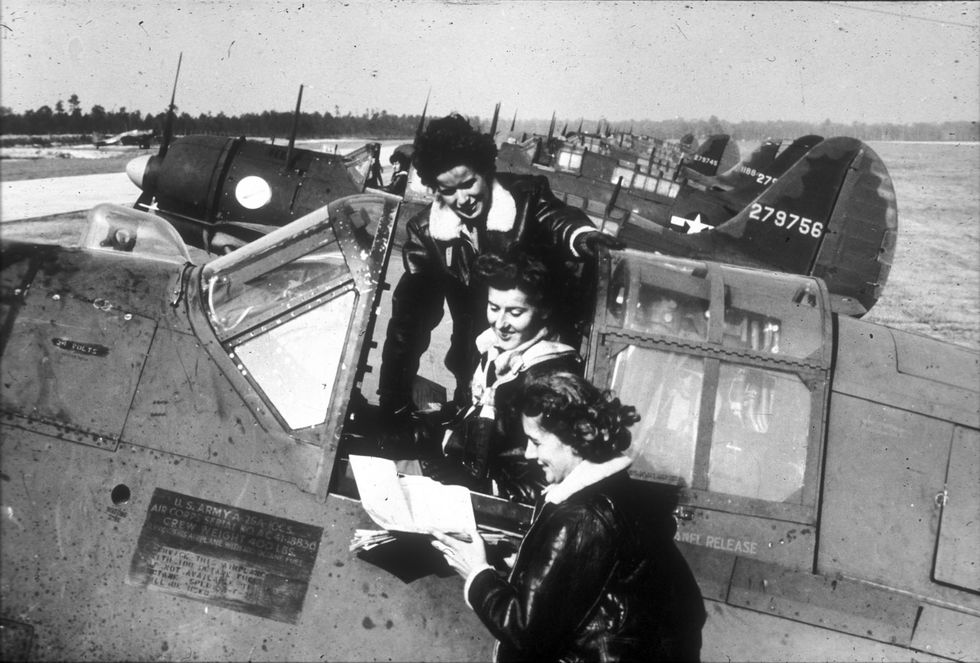Despite those pesky laws and socially indoctrinated ideologies that once existed disallowing women the opportunity to serve their country, there have been brave and bold heroines of wartime. The handful of women below are just a few among many.
1. Soviet Aviators; The night witches
A group of Soviet women under the 588th Night Bomber Regiment assisted the allied forces against the German military and were eventually awarded the Hero of The Soviet Union title after their extreme success and central participation in the defeat of the Nazi regime. This success did not come easily. It is known that because the aviators were women, they only had access to cheap, noisy planes that were unwanted by their male counterparts. These engines to these planes were unreliable and would cut in the middle of their missions, demanding that the women climb out onto the outside of the planes to restart the props by hand midair. Due to the cacophony of the roaring engines, the women feared the noise would give them away to the Germans before they completed their missions. To avoid being detected before dropping their bombs, the women would fly high above their targets, cut the engine and coast down until they reached the desired height to drop the bombs, then restart their engines and quickly escape after deploying the explosives. Their leader flew over 200 missions and was never caught. Eventually, Nazi's nicknamed the women "night witches" because the never heard or saw them, seemingly dropping bombs from the air on broomsticks during the night.
2. American Spies; Alice Marble and Virginia Hall
These two women are some of the most famous female spies in American history. Alice Marble was a champion tennis player, winning 18 Grand Slam championships by the year 1940. After her tennis career, she went undercover as a WWII American spy, obtaining Nazi financial data. She also worked on the editorial advisory board of DC Comics and largely contributed to the creation of Wonder Woman. Virginia Hall was an American spy with the British Special Operations Executive during World War II. Considered one of the most dangerous American spies, she wore many hats. She worked for the Office of Strategic Services, the Speical Activities division and the Central Intelligence Agency. After 15 months hiding out in France, obtaining information on French underground operations, she became the feared and renowned "limping lady" due to her prosthetic foot and was put on the German most wanted list. This, however, did not stop her work during the war. In July of 1943, she was quietly named an Honorary Member of the British Empire for her valuable contributions as an ally.
3. American scientists; Hedy Lamarr and Katherine Johnson
After some brief time as a Czechoslovakian actress, Lamarr became more interested in engineering. During WWII she invented a radio guidance system for torpedoes using a spread spectrum and frequency hopping technology that is widely used today in things like wifi and Bluetooth. She was inducted into the Inventors Hall of Fame in 2014. Katherine Johnson was an aerospace engineer and specialized in celestial navigation. Her efforts as an engineer and mathematician made the Apollo 11 mission possible, sending two American men to the moon during the cold war.
4. Heroines of the Revolutionary War; Deborah Sampson and Sybil Ludington
Deborah Sampson served as a Revolutionary soldier in secret. She disguised herself as a man, serving for a total of 17 months before being shot twice in the leg during a military expedition. She was rushed to the hospital but managed to evade doctors before an examination in fear that her gender would be revealed. Instead of seeking medical treatment, Sampson removed the musket balls from her leg with a sewing needle. Shortly after this, she returned to battle. In 1783 she received an honorary discharge. Sybil Ludington was only 16 years old on the famous night of April 26, 1777, otherwise known as the night Paul Revere rode from town to town alerting the Patriots of the British attack on American Revolutionaries. However, Paul Revere is not the only one who traveled on horseback that night. Ludington did the same, riding for 40 miles on a dark rainy night, over twice the distance as Revere did. She managed to fend off highwaymen attempting to attack her with a stick while she rode through the countryside, assembling around 400 soldiers to defend Danbury, Connecticut.

















